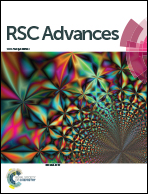Hollow Sn–Ni nanoparticles coated with ion-conductive polyethylene oxide as anodes for lithium ion batteries with superior cycling stability
Abstract
A facile strategy is designed for the fabrication of hollow, Sn–Ni nanoparticles (NPs) surrounded by ion-conductive, polyethylene oxide (PEO) coating to address the structural and interfacial stability concerns facing Sn-based anodes. In the unique architecture of hollow Sn–Ni@PEO NPs, the ductile inactive Ni as a buffer matrix can alleviate the volume change of Sn. Moreover, the synergistic effect between the elastic ion-conductive PEO coating and the hollow interior forces the active Sn to expand inward into the hollow space in the lithiated state, and thus effectively accommodates the substantial volume expansion. In particular, the PEO coating not only suppresses the unfavorable aggregation and pulverization of Sn during cycling, but also helps in forming a stable solid electrolyte interface (SEI) film on the high surface area nanostructured electrodes. Benefiting from the structural features, hollow Sn–Ni@PEO NPs exhibit a reversible capacity of 584 mA h g−1 after 100 cycles with excellent coulomb efficiency of higher than 99%, superior to the bare counterparts. The contribution to the excellent cycling performance by the PEO coating and the hollow structure is verified by galvanostatic charge/discharge cycling, cyclic voltammetry, electrochemical impedance spectroscopy and SEM measurements.


 Please wait while we load your content...
Please wait while we load your content...